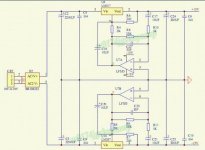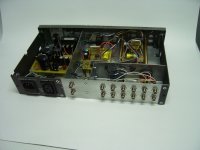If you want standard 50k input impedance why the 100k volume pot? 50k pot is lower noise. Its common to see lower impedances these days, like 10k, as most modern sources have no trouble driving 10k.
I was never able to find a matching pair of 7815/7915. I purchased 20 each of the regulator IC's from DigiKey in US. The highest 7915 output is 0.5 volt lower than the lowest 7815.I made modifications & desing a power supply .... here is the results.
There will be 3 boards:
Power supply
2 audio boards but only one board with '' kill relay ''
I have since switched over to the LM317/LM337 pair which allow trimming the output to match. In fact, I like a servo to further reduce the output noise.

Yes, opamp IC has high CMRR. An exact match of the PSU rails is not necessary. It just bugs me for no good reason. But why not if it can be done with no additional complexity to the circuit.There is no need to match the +/-15V supplies exactly
Exact match betwen + 15V & - 15V is not critical .... as far as I know ..... but power supply noise should be as low as possible ..... 7815 and 7915 does not gives the lowest noise possible ...... but are simple to use this is why I use them ...... you may reed more informations if you go to pitchfork thread .... by ostripper ..... he gives a bette solution to this problem ....
noise is not really a problem, you have to realize the opamps have lots of PSRR to deal with it. the 7815 are less noise than the lm317, look at the specs.
if you need lower noise, then use a C multiplier, but it is not required unless you have a discrete design that has poor PSRR.
if you need lower noise, then use a C multiplier, but it is not required unless you have a discrete design that has poor PSRR.
Exact match betwen + 15V & - 15V is not critical .... as far as I know ..... but power supply noise should be as low as possible ..... 7815 and 7915 does not gives the lowest noise possible ...... but are simple to use this is why I use them ...... you may reed more informations if you go to pitchfork thread .... by ostripper ..... he gives a bette solution to this problem ....
Agree with both of you. As DIYer, I do what I can at cost I can afford, not necessarily the lowest denominator nor a cost no objection approach.noise is not really a problem, you have to realize the opamps have lots of PSRR to deal with it. the 7815 are less noise than the lm317, look at the specs.
if you need lower noise, then use a C multiplier, but it is not required unless you have a discrete design that has poor PSRR.
In general, op amp based circuit are very forgiving in PS. It is more important to get the genuine chip from reliable source. Fortunately in US, a few industry supplier are willing to make retail (small quantity) sales. I usually deal with DigiKey, Mouser or Newark to avoid getting fake parts.
...The highest 7915 output is 0.5 volt lower than the lowest 7815....
So find a pair with 0.6V difference and throw a Silicon diode in the ground of the lower-V unit.
Though I think any circuit that "cares" about +/- equality is flawed. (I knew one, once, and spent half my time trimming the power supply.) Each rail should only have to be "enough" for the signal you put through. With hi-fi 3V peak levels, -6V and +24V would be odd, but fine.
I made most of the hardware .. starting with a QUAD 34 shell ( damaged beyond repair ) and made an aluminium front plate and a few sheetmetal parts.
At left in the back input jacks selector switch and volume control.
At right power transformer voltage regulator board switch and pilot light.
In the center audio boards and output jacks
All audio RCA jacks linked with a brass sheet ... central ground.
At left in the back input jacks selector switch and volume control.
At right power transformer voltage regulator board switch and pilot light.
In the center audio boards and output jacks
All audio RCA jacks linked with a brass sheet ... central ground.
Attachments
Now it is working ... very good result according to me .... will de used most of the time for television sound or FM broadcast....
I would lihe to thank poeple who help me and give me many advice.
I would lihe to thank poeple who help me and give me many advice.
Attachments
- Home
- Source & Line
- Analog Line Level
- Basic preamp circuit






